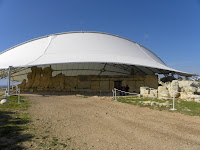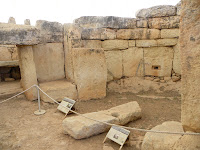The Sunday Jump: Malta lies ninety-eight kilometers south of Sicily and is an archipelago that covers 300 square kilometers, of which only three islands are inhabited. The capital, Valetta, has a population of 7,000 with many surrounding suburbs that meld into the city. I visited in February because I wanted to see their well-preserved neolithic temples that pre-date Stonehenge, the palace of Knossos, and the Egyptian pyramids.
But, of course, I found a treasure trove of so much more. The Greeks settled the island in 700 BC and called it Melite or honey-sweet due to its large population of bees. After the Greeks, Malta became part of the Roman Empire and, according to the Bible's Acts of the Apostles, St. Paul was shipwrecked here for three months. The city of Rabat still preserves the catacombs where St. Paul purportedly stayed.
By 900 A.D. the Arabs ruled the island, from which the Maltese developed their language. Today, they speak a Semitic tongue and use a Latin script.
After the Arabs, Malta was ruled by a series of monarchs until the Knights of St. John received a perpetual lease in 1530. Now known as the Knights of Malta, this Order built the breathtaking limestone fortifications and watchtowers that still line the inner-harbor around Valetta and its suburbs.


Napoleon captured Malta and he was overthrown by the Maltese thanks to ammunition provided by the Kingdom of Naples, the Kingdom of Sicily, and Great Britain. Malta then came under British rule -- the likely reason why the Maltese all speak English so well. They were granted independence in 1964 and today are part of the EU, using the Euro for their currency.
The Neolithic Temples of Malta, however, were the highlight of my visit. Archeologists believe settlers from Sicily first came to the island in 5,200 B.C. At that time, dwarf hippos and dwarf elephants still roamed the area. By about 3,500 B.C. these neolithic people built a myriad of temples (I counted at least seven the Maltese have preserved), but little is known about these ancient inhabitants, except for what we see in these stones.
Tarxien is located in the middle of a bustling city only a few kilometers from the Valetta harbor. A UNESCO World Heritage Site, you can walk to an inner temple where a hearth, an offering bowl, and columns give visual evidence that this must have once been an architectural wonder.

In the southwest region of the island about a one-hour bus ride from Valetta, the Hagar Qim stands on a ridge overlooking the sea. Scientists have created a large tent that cover the stones in order to preserve them from the elements. A trilithon structure (two vertical stones supporting a third stone set horizontally on the top) leads to a passageway, in the middle of which a circular area seems to have been used for offerings and rituals.


A small walk down the hill leads to yet another temple, known as Mnajdra. Again protected by a tent, some of these mammoth stones have markings, which archeologists believe may have been a calendar. One passageway going through a trilithon leads to an inner sanctuary. Here, during the summer and winter solstice, the sun shines in a point at the center of the temple. During the equinoxes, the sun runs through the passageway in a perfect line.


Interestingly, this neolithic culture vanished in 2,500 B.C. and the island remained uninhabited by humans until the Greeks. Archeologists stipulate that the people disappeared due to famine or disease, rather than war because no weapons were found in the area. But who were these people that knew so much about architecture and astronomy? And what really happened to them? Some speculate that Plato's account of lost Atlantis might have been this lost culture in Malta.




No comments:
Post a Comment